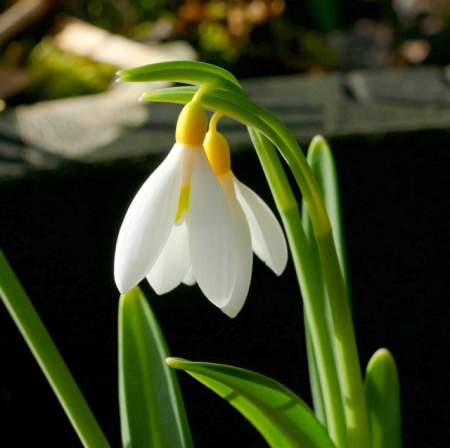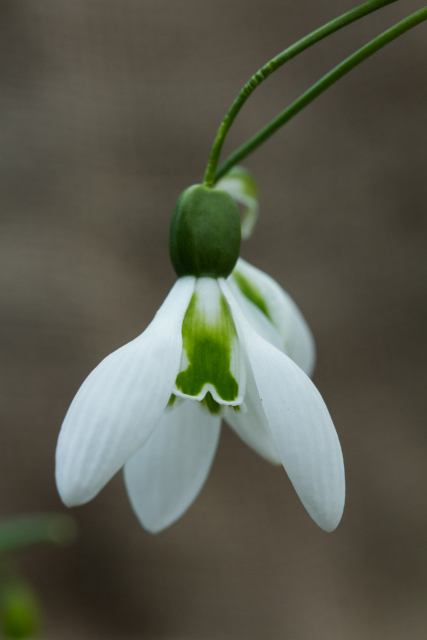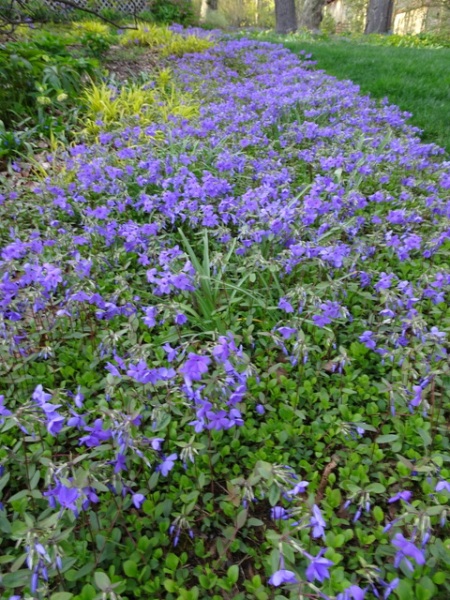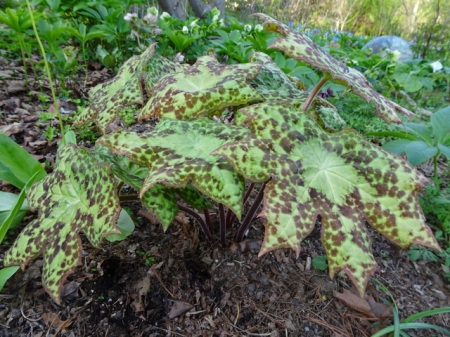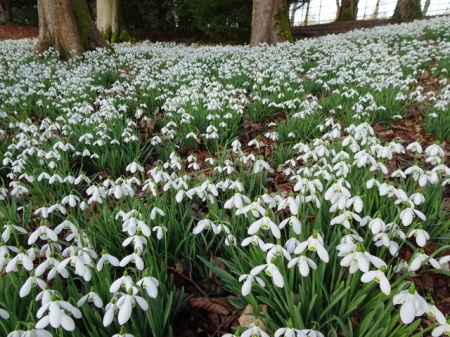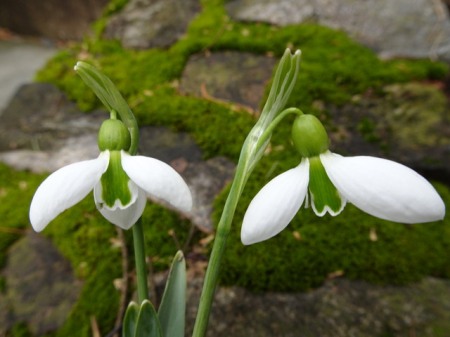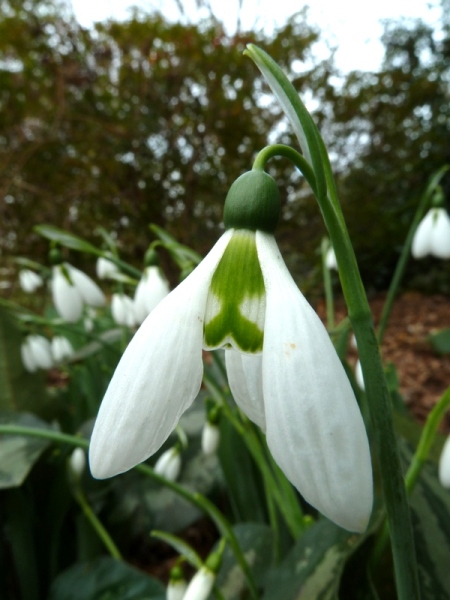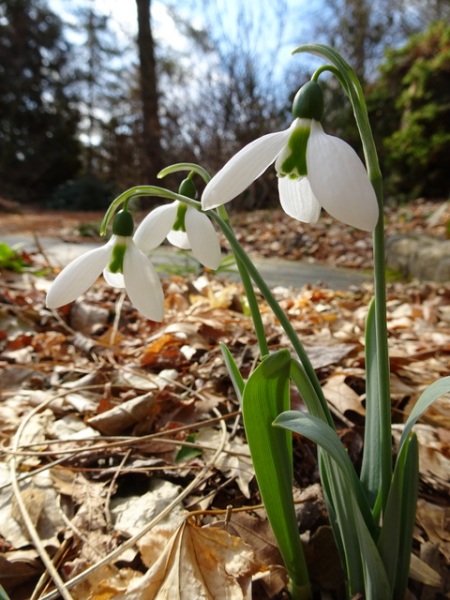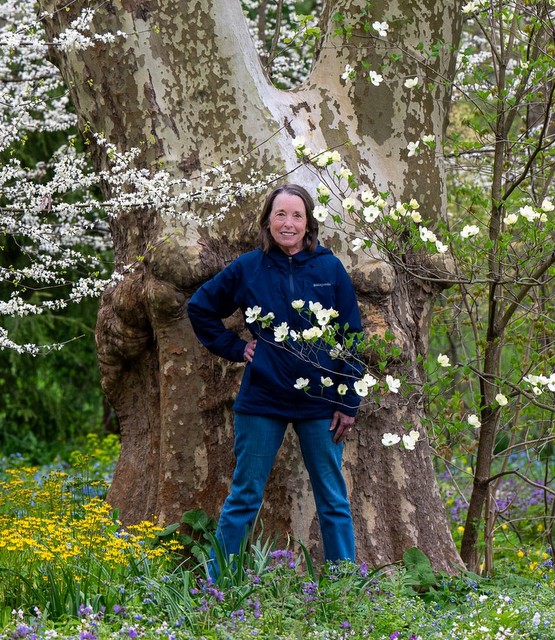 ‘Midas’ has yellow marks on the outer segments, something entirely new to the snowdrop world.
‘Midas’ has yellow marks on the outer segments, something entirely new to the snowdrop world.
Our current snowdrop catalogue is on line here.
Getting outside in the fall to clean out and mulch my snowdrop beds always lift my spirits as we sink into winter. Seeing the little green tips beginning to push through the soil is a sign of renewal when the light is fading, the temperature is dropping, and the rest of the garden is dying back.
When inside, I am busy drafting the 2022 Snowdrop Catalogue, which will be posted on our website in the first half of December. While my loyal snowdrop customers wait to receive their catalogue notification, this post will give everyone an advance look (sorry, no advance orders) at some of the special, new snowdrops that will be available. Enjoy!
Nursery News: Carolyn’s Shade Gardens is a retail nursery located in Bryn Mawr, PA, specializing in showy, colorful, and unusual plants for shade. The only plants that we ship are snowdrops within the US. For catalogues and announcements of local events, please send your full name, mailing address, and cell number to carolyn@carolynsshadegardens.com and indicate whether you are interested in snowdrops. Click here to get to the home page of our website for catalogues and information about our nursery and to subscribe to our blog.
.
. Alan Street at Avon Bulbs sent me this photo of ‘Midas’ in 2017, the year it was introduced. I couldn’t believe my eyes—here was a swarm of one of the world’s rarest snowdrops!
Alan Street at Avon Bulbs sent me this photo of ‘Midas’ in 2017, the year it was introduced. I couldn’t believe my eyes—here was a swarm of one of the world’s rarest snowdrops!
‘Midas’ was discovered in February 2011 by snowdrop expert Alan Street in the famous Avon Bulbs copse of trees where many unusual and popular snowdrops have originated. It was found in close proximity to ‘Blonde Inge’ and ‘Trym’, its presumed parents. A few days later Avon hosted the famous Immortals Luncheon for the exclusive group of people for whom snowdrops have been named. As the immortals would be exploring the copse with their eagle eyes, ‘Midas’ was ignominiously concealed under a pot. Avon introduced it for sale in 2017.
.

.
‘Midas’ has many fine qualities: Like ‘Blonde Inge’, its ovary is green while its markings are yellow, a very pleasing combination. Like ‘Trym’ and its numerous progeny, it is an inverse poculiform, meaning its outer segments have been replaced by a whorl of inners. But what makes ‘Midas’ really special are the yellow markings on the outer segments in addition to the inners.
‘Midas’ is a so-called color change snowdrop—it comes out green and changes to yellow—so plant it where it gets some sun to bring out the beautiful, warm golden color. As an x valentinei, it has the expected vigor of a hybrid snowdrop.
.
 ‘Augustus’ is classically elegant and award-winning.
‘Augustus’ is classically elegant and award-winning.
‘Augustus’s striking, rounded and quilted flowers with emerald green inner segments stand out in any snowdrop collection. Its blooms sit atop robust and perky plants, unbeatable when massed. It has the folded leaves of a G. plicatus but with unusually wide, bright green leaves with a distinct broad silver channel in the center.
.
 ‘Augustus’ is very striking in a group, here in Hilary and Hugh Purkess’s garden “Welshway”.
‘Augustus’ is very striking in a group, here in Hilary and Hugh Purkess’s garden “Welshway”.
‘Augustus’ was found by famous plantswoman Amy Doncaster in the garden of Lewis Palmer at Headbourne Worthy, Winchester, and named prior to 1976 for E.A. (Edward Augustus) Bowles. It has received the coveted Royal Horticultural Society Award of Garden Merit, given to only 28 snowdrops out of the over 2,500 in cultivation.
.
 ‘Cowhouse Green’, shown here at Carolyn’s Shade Gardens.
‘Cowhouse Green’, shown here at Carolyn’s Shade Gardens.
‘Cowhouse Green’ is a virescent or green-shaded snowdrop. Gorgeous apple green shading covers the apical half of the outer segments and lightly washes the inner segments—it glows in my garden at dusk. It is instantly recognizable for its ethereal coloring, tall flower scapes, and elegantly curved flower stems (pedicels). It was found by French horticulturist Mark Brown in the late 1980s in the garden of Susan Cowdy at Rushmere, The Lee, Buckinghamshire, in an area near Cowhouse Field.
.
 ‘Desdemona’ is a Greatorex double snowdrop.
‘Desdemona’ is a Greatorex double snowdrop.
‘Desdemona’ was selected by Heyrick Greatorex from his crosses of G. plicatus with G. nivalis ‘Flore Pleno’. He named his vigorous selections for Shakespeare characters, here Othello’s wife in the Shakespeare tragedy of the same name. ‘Desdemona’ is one of the largest and strongest Greatorex doubles and considered one of the best for garden display.
.
 ‘Desdemona’ at Evenley Wood Garden in Northhamptonshire, a snowdrop venue well worth visiting.
‘Desdemona’ at Evenley Wood Garden in Northhamptonshire, a snowdrop venue well worth visiting.
.
 ‘Moses Basket’ cannot be mistaken for any other snowdrop. Many thanks to Margaret and David MacLennan, holders of the UK National Collection of Galanthus (Scientific), for the wonderful photo.
‘Moses Basket’ cannot be mistaken for any other snowdrop. Many thanks to Margaret and David MacLennan, holders of the UK National Collection of Galanthus (Scientific), for the wonderful photo.
‘Moses Basket’ is a very unique cultivar of G. elwesii with two pale spots resembling eyes in the middle of the inner segments and very small dark green marks at the apex. What makes this snowdrop so special is that when well established the claws (the narrow section at the base of the outer segments) pull the outers in to form a basket with the two eyes peeking out (is that Moses?).
It was discovered in 2004 at Anglesey Abbey in Cambridgeshire by the Assistant Head Gardener David Jordan. The snowdrop was named for the grandson of a longtime visitor to Anglesey Abbey and refers to the basket that floated the biblical baby Moses down the Nile.
.
 ‘Rodmarton Arcturus’ at the famous snowdrop destination Rodmarton Manor in England.
‘Rodmarton Arcturus’ at the famous snowdrop destination Rodmarton Manor in England.
‘Rodmarton Arcturus’: In February 2018, I was given a tour of the snowdrops at Rodmarton Manor in Gloucestershire by the owner, Simon Biddulph, who showed me this snowdrop, which he selected and named for the brightest star in the northern celestial hemisphere. At the time, I called it one of the most impressive snowdrops I have ever seen, click here. My superlatives have been born out by none other than Matt Bishop, the author of the snowdrop bible, who describes it in his catalogue as “one of the ten cultivars which I would take with me if sent to live on a desert island”.
.
 An enviable clump of ‘Rodmarton Arcturus’ in the garden of snowdrop expert Ronald Mackenzie.
An enviable clump of ‘Rodmarton Arcturus’ in the garden of snowdrop expert Ronald Mackenzie.
‘Rodmarton Arcturus’ has enormous, globular, thick-textured, seersuckered flowers with wide, rounded petals like a spoon and a dark green apical inner marking diffusing to two eye-like spots—an absolute standout! The excellent habit and attractive, glaucous, blue-green leaves with slight pleating, indicating G. plicatus parentage, complete the package.
.
Blogs are a lot more fun for everyone, especially the writer, when readers leave comments. Scroll down to the end of the page to the box where it says “Leave a Reply” and start typing—-it’s easy!
Carolyn
.
Note: Every word that appears in orange on my blog is a link that you can click for more information. If you want to return to my blog’s homepage to access the sidebar information (catalogues, previous articles, etc.) or to subscribe to my blog, just click here.

